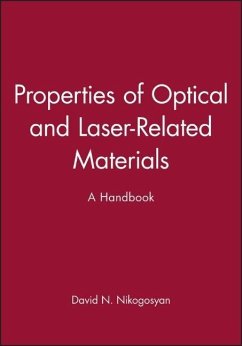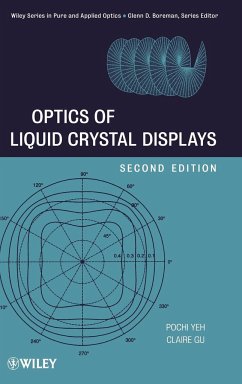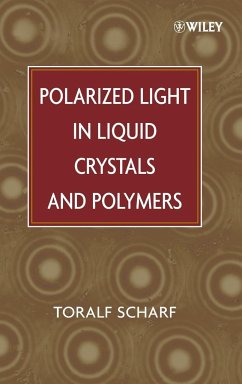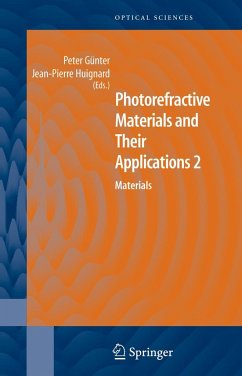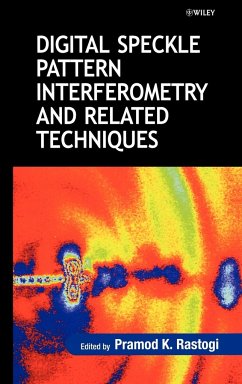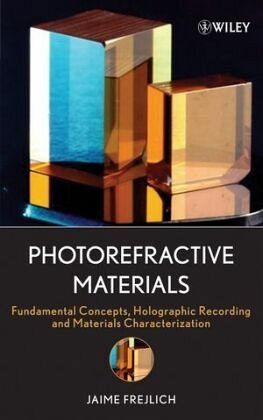
Photorefractive Materials
Fundamental Concepts, Holographic Recording and Materials Characterization

PAYBACK Punkte
87 °P sammeln!
The science needed to understand and undertake photorefractive materials researchPhotorefractive Materials presents an overview of the basic features and properties of photorefractive materials, covering a wide array of related topics. It provides a coherent approach suitable for introductory and advanced students seeking to learn or review the fundamentals, as well as senior researchers who need a reference while investigating more specialized areas.Photorefractive Materials is divided into four parts:_ Fundamentals reviews the basic properties of the electro-optical effect, photoconduc tivit...
The science needed to understand and undertake photorefractive materials research
Photorefractive Materials presents an overview of the basic features and properties of photorefractive materials, covering a wide array of related topics. It provides a coherent approach suitable for introductory and advanced students seeking to learn or review the fundamentals, as well as senior researchers who need a reference while investigating more specialized areas.
Photorefractive Materials is divided into four parts:
_ Fundamentals reviews the basic properties of the electro-optical effect, photoconduc tivity, and photochromism, all in relation to understanding how materials respond to light.
_ Holographic Recording deals with the build-up of a space-charge electric field, the associated volume hologram, the diffraction of light by this hologram, and the mutual interaction between the recording beams and the hologram being recorded (wave-mixing). Special attention is paid to feedback-controlled holographic recording, which greatly increases control over the recording process.
_ Materials Characterization describes optical techniques for characterizing photorefractives and measuring their parameters. Special attention is given to holographic phase modulation in two-wave mixing and self-stabilized holographic recording techniques. Mixed techniques like photoconductivity are also incuded.
_ Applications covers two well-known applications: measurement of vibrations and deformations, and fabrication of diffractive fixed holographic optical components. These two applications are paradigmatic in terms of uses and materials in the field.
In addition to these sections, helpful appendices lay out topics of interest to those working with photorefractives in the laboratory. Throughout the book, experimental data and results are included, keeping theory and practical experience closely linked. Clearly organized for effective pedagogy, Photorefractive Materials is the definitive introduction to this exciting field of study.
FIGURE ON THE COVER: Bi12GeO20 polished crystals grown by Dr. Jean Claude Launay at the Institut de Chimie de la Matière Condensée de Bordeaux, Bordeaux, France: The large thin plate on the bottom is a Cr-doped sample, the bigger crystal on the left-hand side is Fe-doped and the smaller on the right-hand side is undoped.
Photorefractive Materials presents an overview of the basic features and properties of photorefractive materials, covering a wide array of related topics. It provides a coherent approach suitable for introductory and advanced students seeking to learn or review the fundamentals, as well as senior researchers who need a reference while investigating more specialized areas.
Photorefractive Materials is divided into four parts:
_ Fundamentals reviews the basic properties of the electro-optical effect, photoconduc tivity, and photochromism, all in relation to understanding how materials respond to light.
_ Holographic Recording deals with the build-up of a space-charge electric field, the associated volume hologram, the diffraction of light by this hologram, and the mutual interaction between the recording beams and the hologram being recorded (wave-mixing). Special attention is paid to feedback-controlled holographic recording, which greatly increases control over the recording process.
_ Materials Characterization describes optical techniques for characterizing photorefractives and measuring their parameters. Special attention is given to holographic phase modulation in two-wave mixing and self-stabilized holographic recording techniques. Mixed techniques like photoconductivity are also incuded.
_ Applications covers two well-known applications: measurement of vibrations and deformations, and fabrication of diffractive fixed holographic optical components. These two applications are paradigmatic in terms of uses and materials in the field.
In addition to these sections, helpful appendices lay out topics of interest to those working with photorefractives in the laboratory. Throughout the book, experimental data and results are included, keeping theory and practical experience closely linked. Clearly organized for effective pedagogy, Photorefractive Materials is the definitive introduction to this exciting field of study.
FIGURE ON THE COVER: Bi12GeO20 polished crystals grown by Dr. Jean Claude Launay at the Institut de Chimie de la Matière Condensée de Bordeaux, Bordeaux, France: The large thin plate on the bottom is a Cr-doped sample, the bigger crystal on the left-hand side is Fe-doped and the smaller on the right-hand side is undoped.




